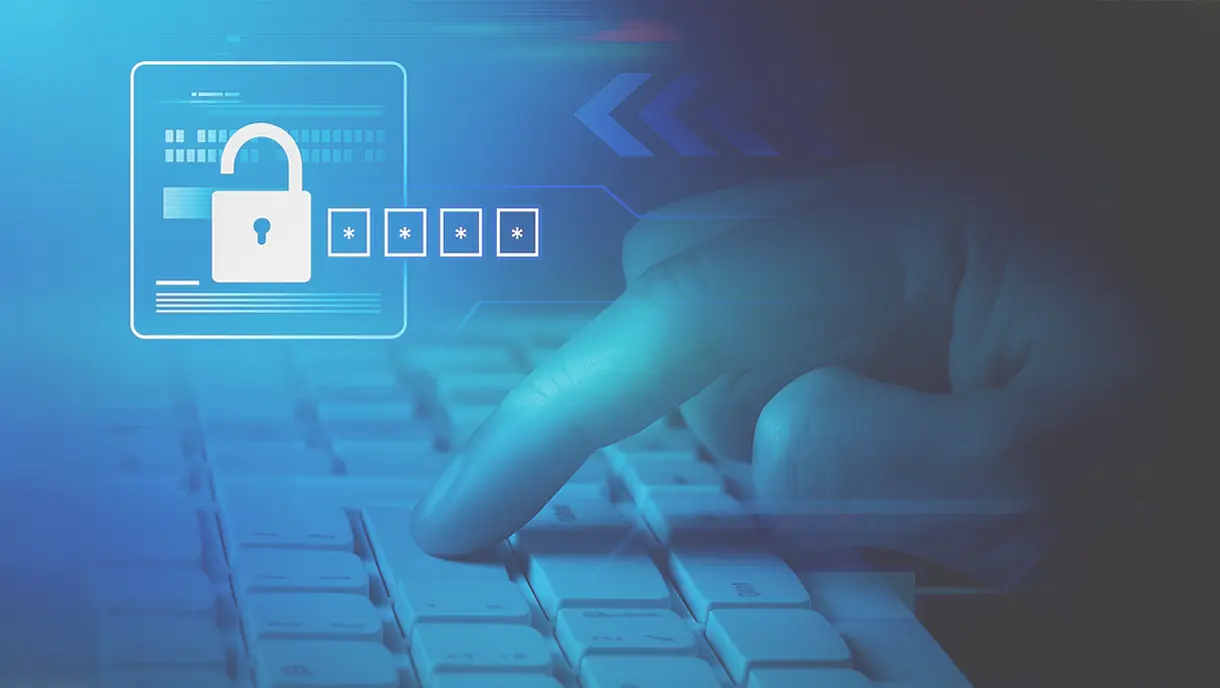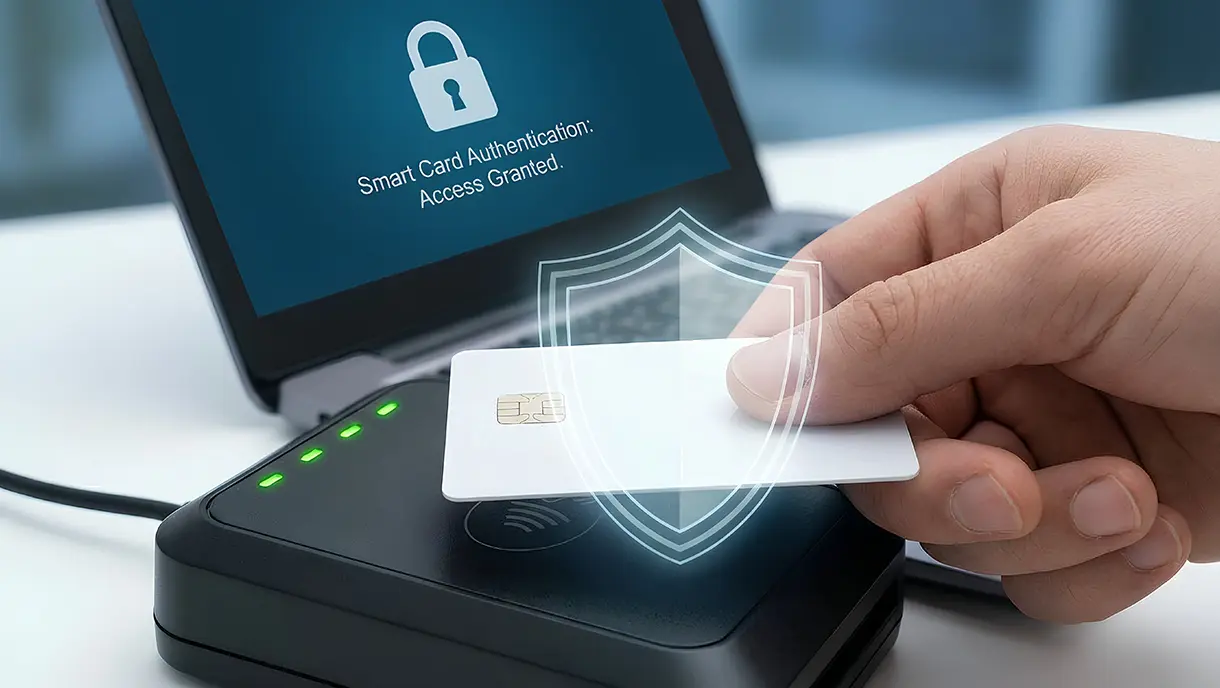PIN Authentication: How It Powers Modern Business Security
PIN authentication revolutionizes workplace security by eliminating password vulnerabilities while providing instant access for frontline workers using shared devices. This technology offers superior phishing resistance through local validation and integrates seamlessly with comprehensive passwordless solutions that combine biometric verification, badge access, and NFC cards. Explore how PIN authentication works and how it can improve your security in this detailed guide.

Are your employees struggling with remembering complex passwords? Are you concerned about unauthorized access to sensitive data or the high cost of a potential security breach? With cyberattacks becoming increasingly sophisticated, even small gaps in authentication can be costly.
The global average cost of a data breach reached $4.4 million in 2025, a 9% decrease from the previous year, mainly due to faster detection and containment. However, the financial and reputational risks remain substantial, according to IBM’s report.
This is where PIN authentication comes in. Offering a simple, fast, and user-friendly way to verify identity, a Personal Identification Number (PIN) strikes a balance between convenience and security.
In this blog, we’ll explore how PIN authentication works, its advantages and limitations, and best practices to help organizations protect sensitive data without burdening users.
What is PIN Authentication?
PIN authentication is a method of verifying a user’s identity using a Personal Identification Number (PIN). A PIN is a short numeric code, usually 4 to 8 digits, that acts as a key to access devices, accounts, or applications. Unlike passwords, PINs are generally easier to remember and faster to enter, making them ideal for quick authentication on mobile devices, ATMs, and point-of-sale systems.
PINs work by linking the numeric code to a specific user account or device. When a user enters the correct PIN, the system verifies it against stored credentials and grants access. While simple, PIN authentication can provide a robust layer of security, especially when combined with additional measures like device encryption or multi-factor authentication.
With the basics of PIN-based authentication clear, let’s now explore how PIN works. The coming section will shed light on this topic.
How PIN Authentication Works: Complete Process
PIN authentication follows a simple yet effective verification flow to ensure only authorized users gain access. Here’s the step-by-step process:
1. PIN Setup
Users create a personal PIN, typically 4–8 digits, which is associated with their account or device. During setup, best practices like avoiding repetitive or sequential numbers (e.g., 1111 or 1234) are recommended to enhance security.
2. Input at Login or Access Point
When accessing a device, app, or service, the user enters their PIN. This can be on an ATM, smartphone, point-of-sale terminal, or web application.
3. Verification by the System
The system checks the entered PIN against the stored reference. For device-specific PINs, the verification happens locally. For networked systems, the PIN may be verified against a secure server.
4. Access Granted or Denied
If the PIN matches the stored credentials, access is granted. If the PIN is incorrect, the system denies access and may trigger security measures, such as temporary lockouts or alerts, after multiple failed attempts.
5. Optional Security Enhancements
Many organizations combine PIN authentication with additional layers, such as:
- Device Encryption: Ensures data remains protected even if the device is compromised
- Multi-Factor Authentication (MFA): Adds another verification factor, such as biometrics or a one-time code
- Behavioral Analytics: Monitors usage patterns to detect unusual access attempts
This process strikes a balance between speed, simplicity, and security, making PIN authentication a reliable choice for both individual users and organizations. Next, let’s explore how PIN authentication differs from other popular authentication methods, such as passwords and biometrics.
PIN Authentication vs. Passwords vs. Biometrics: What’s The Difference?
While PINs, passwords, and biometrics serve as authentication methods, they differ in purpose and security approach. Here’s a difference between the three:
PIN authentication emerges as the optimal choice for shared device environments where frontline workers require fast and secure access. It eliminates password vulnerabilities while avoiding the high costs and environmental limitations of biometric authentication.
What Are the Benefits of PIN Authentication?
PIN authentication transforms how frontline workers access shared devices across industries. From factory floors to hospital wards, PIN systems eliminate the friction and security gaps that plague traditional authentication methods.
1. Fast, Frictionless Access
PIN authentication enables instant access for workers using shared tablets, PCs, or kiosks throughout their shifts. Employees enter their numeric code in under two seconds without typing complex passwords or waiting for system verification. This speed advantage proves critical during busy periods when every second counts for productivity.
Shift changes happen seamlessly as workers log in and out of shared devices with minimal delay. Manufacturing terminals, healthcare workstations, and retail point-of-sale systems maintain high throughput when PIN authentication eliminates login bottlenecks.
2. Local Security and Recovery
PINs get validated locally on devices without requiring constant network connectivity. This local validation ensures workers maintain access during network outages or connectivity issues that would otherwise halt operations. Manufacturing facilities and remote healthcare locations benefit enormously from this resilience.
Offline capability means that shared devices continue to function even when internet connections fail. Workers access critical applications and data through PIN authentication regardless of network status, maintaining business continuity during technical disruptions.
3. Universally Accessible
PIN authentication works perfectly for non-tech-savvy workers who struggle with complex password requirements. Frontline employees in industries such as manufacturing, who often lack personal email accounts or smartphones, can use shared devices immediately by simply entering numeric codes. It proves essential in high-turnover industries like retail and hospitality.
New employee onboarding becomes effortless when workers only need to remember four to eight digits. PIN systems eliminate barriers that prevent frontline staff from accessing the tools they need to perform their jobs effectively.
4. Multi-Platform Consistency
PIN authentication works seamlessly across various industries, including manufacturing, retail, healthcare, and contact centers, through integrated identity platforms. Workers experience identical login processes regardless of whether they use factory terminals, hospital workstations, or customer service kiosks. This consistency reduces training requirements and user confusion.
Cross-platform integration allows PIN systems to connect with existing access control systems, time clocks, and business applications. Organizations deploy PIN authentication once and extend it across all shared device environments for unified security management.
These benefits combine to create seamless operations where employees focus on their work rather than wrestling with authentication barriers. For organizations managing high-turnover environments and shared devices, PIN systems provide the foundation for productive, secure, and accessible workplace technology.
[[cta]]
5 Best Practices for Secure and Fast PIN Authentication
Implementing PIN authentication successfully requires following security best practices that protect against attacks while maintaining user convenience. These actionable steps ensure enterprise deployments achieve maximum security benefits for frontline workers and shared device environments.
1. PIN Complexity and Length
Longer and more complex PINs provide the first line of defense against unauthorized access. Six-digit or longer PINs drastically increase the number of possible combinations, making brute-force attacks much harder, while still being easy to remember. Avoid common patterns, such as repeated digits or sequential numbers.
What to Do
- Require PINs to be at least 6 digits long.
- Prohibit sequential or repeated numbers (e.g., 123456, 111111).
- Educate users on creating unique, memorable PINs.
- Align PIN policies with enterprise security standards.
2. Local Hashing and Encryption
Storing PINs securely is critical. Using strong hashing algorithms with unique salts protects credentials even if databases are compromised, making it practically impossible for attackers to reverse-engineer the PINs.
What to Do
- Use secure hashing algorithms such as Bcrypt, Argon2, or Scrypt.
- Assign a unique salt to each user’s PIN.
- Perform PIN validation locally whenever possible to avoid transmitting sensitive data over networks.
- Regularly review and update encryption parameters to stay ahead of computational attacks.
3. Retry Limits and Lockouts
Limiting PIN entry attempts prevents automated attacks and brute-force guessing. Implementing temporary lockouts and escalating delays after multiple failed attempts protects both users and systems.
What to Do
- Set retry limits (e.g., 3–5 failed attempts) before temporary lockout.
- Introduce time delays between successive attempts (progressive throttling).
- Monitor failed attempts to detect potential security threats.
- Ensure legitimate users can regain access without permanent lockouts.
4. Seamless Reset and Recovery Flows
Secure and user-friendly PIN reset processes are crucial for maintaining productivity while minimizing IT intervention. Multi-factor verification ensures unauthorized users cannot change PINs.
What to Do
- Offer self-service PIN reset options for frontline workers.
- Include verification steps such as supervisor approval, security questions, or biometric confirmation.
- Automate workflows to guide users through the reset process securely.
- Maintain audit trails for compliance and monitoring purposes.
5. PINs in Multi-factor Authentication
PINs are most effective when combined with additional authentication factors. Multi-factor authentication enhances security by layering “something you know” (PIN) with “something you have” or “something you are” verification.
What to Do
- Combine PIN entry with biometrics, security tokens, or proximity cards.
- Configure backup authentication methods to ensure access continuity.
- Adapt MFA deployment to match risk levels and data sensitivity.
- Educate users on combining PINs with advanced authentication methods for convenience and security.
These best practices create the foundation for successful PIN authentication deployments across enterprise environments. Following these guidelines ensures shared devices remain secure while providing the frictionless access that frontline workers need for productive operations.
5-Phase PIN Authentication Implementation Process
The successful setup of PIN authentication follows a structured approach that minimizes disruption while maximizing the security benefits. Organizations achieve the best results when they plan carefully and roll out systems in phases across shared devices and frontline environments.
Phase 1: Planning and Assessment
The implementation process begins with comprehensive planning to understand organizational needs and existing infrastructure. This foundation phase determines project scope and secures necessary resources for success.
- Requirements assessment identifies all shared devices, user populations, and existing authentication systems.
- Hardware compatibility evaluation ensures PIN systems work with current tablets, kiosks, and workplace terminals.
- Integration planning maps connections to HRIS, Active Directory, and SSO platforms.
- Executive sponsorship secures adequate resources and organizational commitment.
- Project scope definition establishes clear objectives, timelines, and success metrics.
Phase 2: Design and Configuration
Once the requirements are precise, teams design authentication workflows tailored to the specific needs of the workplace. This phase creates the technical foundation that supports frontline workers across various operational scenarios.
- Authentication workflows are designed around specific workplace scenarios and user roles.
- PIN policies define complexity requirements, reset procedures, and security standards.
- Integration architecture connects with existing identity management systems.
- Automated provisioning workflows eliminate the need for manual user setup through HRIS integration.
- Security configuration implements local PIN validation and lockout policies.
Phase 3: Pilot Testing
Before full deployment, organizations test PIN authentication with representative user groups in real-world environments. This validation phase identifies potential issues and optimizes user experience before widespread rollout.
- Pilot group selection includes diverse user populations and device types.
- Real-world testing in manufacturing, healthcare, or retail locations.
- User training introduces PIN creation and device access procedures.
- Feedback collection captures user experiences and system performance data, providing valuable insights into the overall user experience.
- System optimization addresses issues discovered during 2-4 week testing periods.
Phase 4: Production Rollout
After successful pilot validation, phased deployment systematically implements PIN authentication across the organization. This controlled approach ensures smooth transitions while maintaining operational continuity.
- A phased deployment implements systems by department or location.
- Automated user onboarding leverages HRIS integration and self-service PIN setup.
- Change management communications keep employees informed about deployment schedules and timelines.
- Support preparation trains IT teams on administration and troubleshooting procedures.
- Go-live support ensures rapid resolution of any authentication issues.
Phase 5: Management and Support
Following deployment, ongoing management ensures that PIN authentication continues to deliver security and efficiency benefits. This maintenance phase focuses on optimization and continuous improvement.
- System monitoring tracks authentication performance and user adoption metrics.
- User support provides PIN reset assistance and troubleshooting help.
- Training programs ensure new employees understand PIN authentication procedures.
- Continuous improvement incorporates feedback and emerging security requirements.
Utilizing this structured process enables the successful deployment of PIN authentication with enhanced security and improved user experiences. The phased approach minimizes operational disruption while enabling iterative improvements based on real-world frontline worker feedback.
[[cta-2]]
Combined Benefits of PIN Authentication & Passwordless Solutions
PIN authentication becomes even more powerful when integrated into comprehensive passwordless solutions that address the full spectrum of workplace security needs. A unified identity platform showcases how PIN systems integrate with biometric authentication, badge access, NFC cards, and QR codes to deliver seamless multi-factor authentication experiences.
This integrated approach transforms workplace security by eliminating password vulnerabilities while providing workers with consistent, reliable access across all shared devices.
- Enhanced security through layered authentication that prevents credential-based attacks.
- Reduction in IT support costs by eliminating password reset tickets and helpdesk calls.
- Instant access for workers using their preferred authentication method in any environment.
- Complete compliance with audit trails spanning physical and digital access points.
- Environmental adaptability, where PINs provide backup when biometric scanners face challenges.
A passwordless authentication platform like OLOID establishes a unified identity framework that encompasses both physical and digital access control, providing a seamless experience. PIN authentication serves as one component in a comprehensive solution that includes face recognition, proximity cards, and mobile credentials.
Creating Secure, Frictionless Workplaces with OLOID
PIN authentication represents a fundamental shift toward secure, efficient workplace access that frontline workers and IT teams both appreciate. The challenges of password complexity, shared device management, and credential theft necessitate modern solutions that strike a balance between security and usability.
PIN systems deliver this balance by providing instant access, local validation, and seamless integration with existing workplace technology. OLOID transforms PIN authentication from a standalone security measure into a comprehensive passwordless platform explicitly designed for frontline environments.
OLOID combines PIN systems with biometric verification, badge access, NFC cards, and QR codes to create flexible multi-factor authentication experiences. This unified approach eliminates the complexity of managing multiple authentication systems while providing workers with consistent access across all shared devices.
Experience the OLOID difference for your organization. Schedule a Demo to see how OLOID transforms workplace authentication for the modern enterprise.
Frequently Asked Questions on PIN Authentication
1. What makes PIN authentication secure in the workplace?
PIN authentication achieves security through several layers of protection. PINs are typically validated locally on devices, reducing exposure to remote attacks and phishing attempts. When properly implemented with strong encryption (using bcrypt, scrypt, or Argon2), unique salts per user, and secure storage in encrypted identity stores, PINs become highly resistant to compromise.
Additionally, lockout policies with retry limits, time-based throttling, and audit logging help prevent brute-force attacks and provide accountability in workplace environments.
2. How can organizations implement PIN authentication effectively?
Organizations should follow a structured approach for PIN implementation. Start by establishing a comprehensive PIN policy that defines length requirements (minimum 6 digits for sensitive applications), complexity rules, and usage guidelines. Implement proper technical controls, including secure hashing, unique salts, and encrypted storage.
Set up lockout mechanisms with retry limits (typically 5 failed attempts) and cooldown periods to prevent brute-force attacks. Finally, integrate PIN authentication with existing identity management systems and provide employee training on security best practices.
3. Can PIN authentication be combined with other identity factors?
Yes, PINs work excellently as part of multi-factor authentication (MFA) systems. They can be combined with biometrics (such as fingerprint or facial recognition), smart cards, access badges, mobile authenticator apps, or hardware tokens to create a robust, layered security system.
This combination leverages different authentication factors: something you know (PIN), something you have (device/card), and something you are (biometrics). Modern platforms like OLOID specifically support PIN integration with various authentication factors for comprehensive workplace security.
4. What should I do if an employee forgets their PIN?
Establish a secure PIN reset process that maintains security while minimizing downtime. Best practices include identity verification through multiple channels such as email confirmation, SMS codes, or manager approval.
Implement self-service reset options that allow users can reset their PINs using alternative authentication methods, such as biometrics or temporary access codes. For workplace environments, consider integration with HR systems for automated identity verification.
Always log reset activities for audit purposes and consider temporary PIN assignments for immediate access needs.
5. Where is PIN authentication most useful in modern workplaces?
PIN authentication excels in shared device environments such as retail point-of-sale systems, healthcare terminals, manufacturing kiosks, and contact center workstations. It's particularly valuable for deskless workers who require quick and frequent access to multiple devices throughout their shifts.
PINs are also ideal for industries with high employee turnover, where secure but straightforward authentication reduces training overhead. Additionally, PIN authentication works well in environments with limited interfaces (IoT devices, smart TVs, ATMs) and mobile-first applications where typing complex passwords is impractical.






Get the latest updates! Subscribe now!




